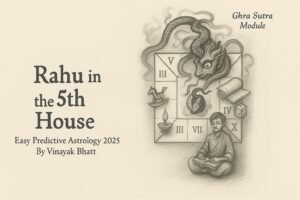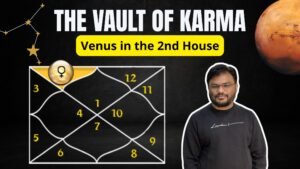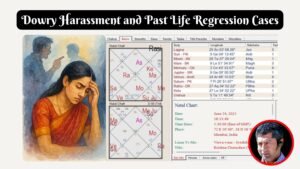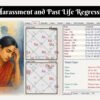How To Time An Event of Shri Dinesh Mathur by Heikki Malaska
Article by Heikki Malaska, Finland
SA Book Reviewer
Index
- Sources for timing of events
- Karaka
- Factor
- Three-point match
- Activating Factor
- Karaka-Factor
- Relationships Between Planets And Houses
- Additional Qualification
- Use of Karakas In Bhrigu Samhita
- Independent Methods Of Timing
- Rectifying The Birthchart
- Images 1-3 For Rectifying Birthchart
1.1 SOURCES FOR TIMING OF EVENTS
When I first started looking into Vimshottari dasha, it seemed quite straightforward concept for timing occurrences and events. The more I applied it, the more confused I started to get, because some aspects just did not produce the results expected and did not follow the basic logic.
In the book “How to Time an Event” by Dinesh S. Mathur, I have discovered timing-related issues that help bring clear light into my confusion and deepen my own understanding. I am writing this article for the purpose of establishing a basis for understanding and further exploration into subject, for myself and hopefully for others as well. If I was required to carry only one English-language Joytish-book onto a desert island with me, I think this book would be it.”
This is the first work in which an attempt has been made to scientifically put to practice concepts relating to progression only hinted at in BHRIGU SAMHITA. This is a unique attempt that has been successfully employed to time events correctly.
Dinesh. S.Mathur: How to Time an Event
Besides Brhat Parashar Hora Shastra and Bhrigu Samhita, D.S Mathur draws the enormous wealth of detailed information in his book from numerous sources, in alphabetical order: Bhavartha Ratnakara (BV Raman translation), Bhartiya Jyotish by Shankar Balkrishna Dikshit, Brihatjatakam by Varahamihira, Jatakabharnam, Jatakadeshmarg Chandrika, Laghu Parashari, Lal Kitab, Phal Deepika, Phalit Vikas of Ram Yatna Ojha, Prasna Marg, Saravali of Kalyan Verma, Sarvanth Chintamani and Uttar Kalamrita by Kalidas.
I also truly apologize for the oversimplification that must occur, in order to fit the profound subject matter of this fascinating 363-page book onto a 6 page article.
2.1 KARAKA
Basis of this system of timing is understanding what is a Karaka. Mr. Mathur states that in Bhrigu Samhita Karakas are used in a dynamic sense. Every house in the birth chart represents certain issues. Every planet functions as Karaka (producer) of certain issues. In his book, D.S. Mathur provides several page long list of Karaka -issues that coordinate houses with planets (page 48 in his book). For example:
|
ISSUE |
KARAKA | HOUSE |
| immovable property | Mars | 4 |
| disputes / litigation | Mars | 6 |
| education | Mercury | 4 |
| business / trade | Mercury | 7 |
| wealth | Jupiter | 2 |
| husband | Jupiter | 7 |
| vehicle | Venus | 4 |
| wife | Venus | 7 |
| debts | Saturn | 6 |
| profession / livelihood | Saturn | 10 |
| etc. |
|
To identify which issue a planet would manifest in its major period, we look at karakas. Each planet is inclined to give certain results, these are karaka-properties of planets. Karaka is the key to specific issues, it controls the issues for which it is karaka… it is the source of all such events. Karaka imparts its qualities to any element it influences.
The list above can be expanded manifold as the list of karaka significators for each house and planet is virtually unlimited. In the event we cannot relate a matter to a house and corresponding karaka, Parashara has given general principles in chapter 7 verses 39-43 of BPHS:
Dinesh. S.Mathur: How to Time an Event
|
PLANET |
HOUSES TO BE CONSIDERED FROM PLANET |
| Sun | IX, X, XI |
| Moon | I, II, IV, IX, XI |
| Mars | III |
| Mercury | VI |
| Jupiter | V |
| Venus | VII |
| Saturn |
VIII, XII |
Being a Karaka for specific issue, is not enough for a planet to bring out an event or occurrence of that issue, in the life of the native. For that, we need to recognize if a planet can function as “fit receptacle” for the issue – this planet could then manifest the issue in its dasha period.
3.1 FACTOR
Planet which can function as “fit receptacle” for an issue, is called a Factor. It might not be the same as the Karaka -planet for that issue. The Factor requires “activation or impregnation” by the Karaka, in order to manifest the issue in the period of the Factor.
4.1 THREE POINT MATCH
Validation of a planet as a Factor, takes place through the house that represents the issue at hand. In the birthchart:
- Determine the issue
- Determine which house represents the issue
- Determine which planet functions as Karaka for that house/issue
- Then check following 3 points in relation to the planet under examination:
- is the planet related to the house, as counted from the Ascendant?
- is the planet related to the house, as counted similarly from the Arudha Lagna?
- is the planet related to the house, as counted similarly from the Karaka?
If the answer to all 3 questions is “YES”, the planet being examined is a Factor for that issue, meaning it is a “fit receptacle”, it has the potential for bringing out the issue in its dasha period. At this point, you could say the Factor is “on standby”, waiting for activation orders of the Karaka, before it can manifest results.
House taken from the Ascendant represents certain matters. For each such matter, there is a specific planet that signifies the matter, the karaka. Same number of houses from karaka also represents some of the matters that house from the Ascendant represents. Arudha of a house represents matters of that house in a more prominent manner. Thus a house counted from Arudha Lagna will function in same manner as house counted from the Ascendant.
In order to give results on the matter, planet should be related to all three houses. Planet related to one or two of these houses represents possibility, a planet related to all three houses becomes capable of giving results.
In order to actually produce the results, such planet should be authorized by karaka to materialize the results in person’s life.
Dinesh. S.Mathur: How to Time an Event
5.1 ACTIVATING FACTOR
In order to actually manifest results, Factor needs to be “activated or impregnated” by the Karaka of the issue. This means that Factor must be related to the Karaka, in the birthchart. If this relation is verified, then the Factor will manifest the results of that issue during its dasha period. If Factor and Karaka are not related, Factor only carries the dormant potential which does not manifest in actual events or occurrences.
When karaka for particular matter is not Karaka-Factor, it will not be able to give result in its own major period, as it is not a Factor. But it is able to energise another planet to assume the role of Factor for that event.
Dinesh. S.Mathur: How to Time an Event
6.1 KARAKA-FACTOR
A special case of a Factor is the Karaka-Factor. This means that the Factor and the Karaka are one and same planet, in the birthchart. If Karaka of an issue fulfills the conditions of the 3-POINT MATCH, it is not only Karaka but also Karaka-Factor of the issue. This means that in order to be validated also as a Factor…
- Karaka must be related to the house, as counted from the Ascendant
- Karaka must be related to the house, as counted from the Arudha Lagna
- Karaka must be related to the house, as counted from itself.
With these conditions fulfilled, Karaka becomes Karaka-Factor which is both “fit receptacle” for bringing out the issue, and capable of activating itself. Thus it will manifest the issue during its own dasha period.
Fixed karakas are selective in which results they show in their major periods. Karaka can be Karaka-Factor for one of its significations and not for others.
Influence of Karaka-Factor will be lifelong. Influence of a Factor may last only during the major period of the Factor. Thus, when a Factor for deprivation influences Karaka-Factor, the event does not happen during major period of the Factor, but it does not cause lifelong deprivation.
Dinesh. S.Mathur: How to Time an Event
7.1 RELATIONSHIPS BETWEEN PLANETS AND HOUSES
In order to determine which planet produces results in its period and which planet is a Factor, it is essentially important to identify two things:
- which planets relate to which houses
- which planets relate to which planets.
Relating a planet to a house is based mainly on following factors: planet occupies the house, planet owns the house, or planet aspects either the house or another planet in the house. Relationships of planet to a house through navamsha chart, through owner of constellation or through sambandhas, also play their part. In his book Mr. Mathur develops a very detailed classification of possible relationships, and then describes them with numerous examples, in the order of diminishing strength. Here are some general guidelines:
When planet occupies a house, it is considered to be most powerfully related to that house. Each relationship to a house is like a strand, weak relationship is a weak strand. Several weak strands can yet together form a strong rope binding the planet to a house.
Through a weak relationship planet sometimes indicates an event. Such event is unlikely to materialize. The issue can rise to surface for a while and then subside again, without materializing in concrete form. The issue might be thought or discussed about, or it may even start to take shape but fail to develop any further. With weak relation the effect would be only ephemeral and passing.
Some birth charts have almost all planets related to each other; the premise in such case is that each planet is related to almost every one of the 12 houses. In such case, only strong relationships would indicate feasibility of planet to materialize results.
Dinesh. S.Mathur: How to Time an Event
Two planets relate to each other mainly by being in sambandha, or sharing signs between birthchart and navamsha chart. Sambandha can be verified either from birthchart, navamsha chart or from nakshatras. Planet dispositors can also create relations.
8.1 ADDITIONAL QUALIFICATION
Main verification method for determining Factor or Karaka-Factor, is with 3-POINT MATCHING system already explained. Factor and Karaka-Factor do not determine the nature and quality of an event. Sometimes it can also be difficult to determine which of the Factors would manifest actual results. For cases like these, Mathur describes additional qualification tools, such as:
- Does the planet relate to either a Factor for gain, or Factor for loss?
- Relation to Factor for injury would tend to create physical troubles; relation to Factor for enmity would create psychological/emotional problems.
- Arudha of the relevant house from Karaka is a powerful tool to help determine right Factor; this applies equally to planets on all period-levels.
- Planet related to Ascendant and house of issue in relevant divisional varga chart, is preferable to a planet which does not have this connection.
- Qualifying planet should be related to what Mathur calls “Essential Planet”; this is a sub-period planet that is determined by comparing relevant Arudhas, and generally this planet is not the same as Karaka for the issue or event.
9.1 USE OF KARAKAS IN BHRIGU SAMHITA
As already stated, Mathur says that in Bhrigu Samhita Karakas are used in a dynamic sense, and somewhat different from Brhat Parashara Hora Shastra. Traditional aspects are taken. There are fixed rates at which different planets progress. Retrograde planet regresses at same rate as when it would not be retrograde. Lunar nodes are always retrograde, they regress at given rate. Sun and Moon never regress, are never retrograde. Contact through progression between Karaka and Jupiter will materialize event. When a Karaka for marriage, through progression contacts self (Jupiter) then marriage takes place. Method of progressing planets is different from other known methods. Sambandhas remain valid and operate during progressions.
In the first part of his book, Mathur describes 11 different ways of using Karaka properties of planets.
10.1 INDEPENDENT METHODS OF TIMING
About 300 pages of the book describes a detailed analyses of effects and events of major-periods, sub-periods and inter-periods; methods for determining results of different periods; also using the Annual Chart and Transits.
Mathur also gives a detailed description of “independent methods of timing”, which according to him are given in Bhartiya Jyotish and dealt with great detail in Lal Kitab. Instead of using just specific years for each planet, we are dealing here with BAND OF YEARS that repeat after 35 years. Thus if Jupiter operates in 16th-21st year of persons life, it will again operate during 51st-56th years of life etc.
Whenever an event occurs, its Karaka is seen to relate to the planet which rules over the prevalent BAND OF YEARS at that time. This relationship can again be through sign, constellation or navamsha. The ruler of a BAND OF YEARS, who would cause a particular event to occur, would actually be a Factor for that event.
11.1 RECTIFYING THE BIRTHCHART
I shall conclude this book review with an example from the book, which demonstrates the use of Karaka transit in rectifying the birthchart. I have worked out comparison charts, based on data given on pages 260 and 335 in the book.
(see 3 images at the end of this review).
In this chart, the position of Jupiter at birth is open to question, right at the border of two signs. The two charts (IMAGE 1 and IMAGE 2) display the alternatives. To make this clear, I have used 5 minutes of difference in the birthtime, but even smaller amount would suffice. Person’s first child was born on 25.2.1976, and the third chart (IMAGE 3) shows transit information in relation to the earlier birthtime.
The principle is that, at the time of happening of the event, the concerned KARAKA is related to the ARUDHA of the event, and passes on its inclination to materialize a particular event to the period planets. If even one of interperiods does not indicate event, it cannot happen during the combination of periods.
Dinesh. S.Mathur: How to Time an Event
Karaka for the first child is Jupiter. Please compare alternatives between IMAGE 1 and 2:
IF correct birthtime is 10:16 with Jupiter in Libra… then Arudha of first child (A9) is Libra in house 5.
IF correct birthtime is 10:21 with Jupiter in Virgo… then Arudha of first child (A8) is Scorpio in house 6.
Then examine the Karaka in transit in IMAGE 3.
IF correct birthtime is taken as 10:16, the Karaka of first child (Jupiter) makes 3 connections to Arudha of the first child (Libra in 5th house):
- constellation ruler (Mercury who rules Revati) connects Jupiter to Venus who is ruler of Arudha of first child,
- transiting Venus is in sambandha with Vimshottari MD ruler Saturn, who connects Jupiter to subperiod ruler Venus who is also ruler of Arudha of first child,
- Jupiter is constellation ruler of transiting Rahu who occupies Arudha of first child.
IF correct birthtime is 10:21, similar wealth of connections between relevant Karaka and Arudha of the first child cannot be established.
IMAGE 1 – BIRTHCHART FOR TIME 10:16

IMAGE 2 – BIRTHCHART FOR TIME 10:21

IMAGE 3 – TRANSIT DATA FOR 25.2.1976, THE BIRTHDATE OF FIRST CHILD

About Author: Born 1955 in Lappenranta, Finland. In younger years part time career as street musician, singer and composer of songs. 20 years of private entrepreneurship in digital signal processing, visionary management, consulting, game design and IT-related work also in Nepal. Degree of NLP Master Practitioner in 1997 (NLP Institute), and Degree of Innovative Product & Service Developer (Rastor Business College) in 2010. For the last 12 years has been practicing Sanatana Dharma meditation, study of Vedic sources, Advaita Vedanta and bioenergy management. Picked up study and practice of Jyotish in 2011 (from Maharishi Jyotish) by pure cosmic accident, and has been expanding ever since. Simply cannot get enough.











Leave a reply
You must be logged in to post a comment.